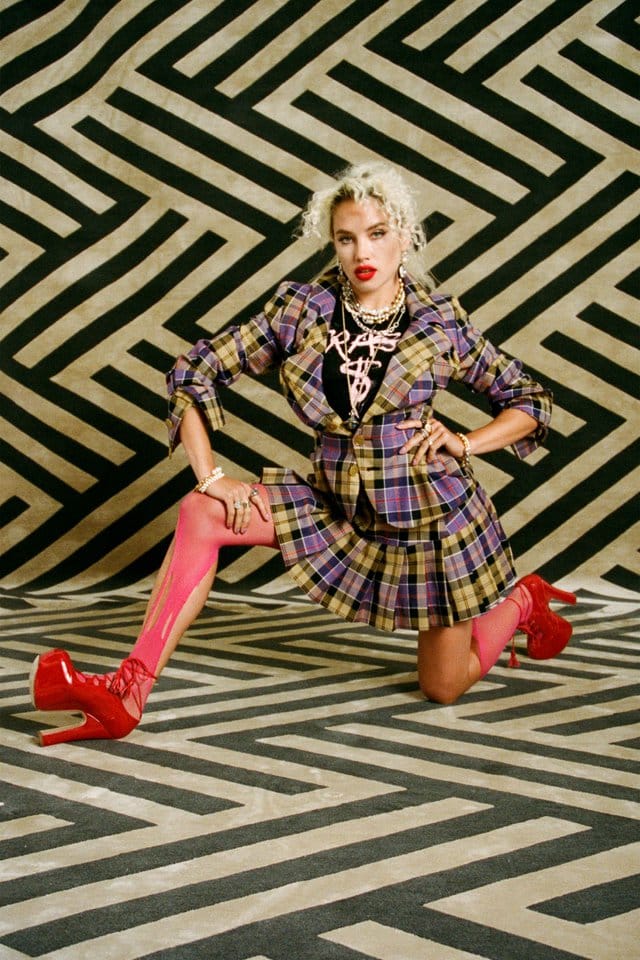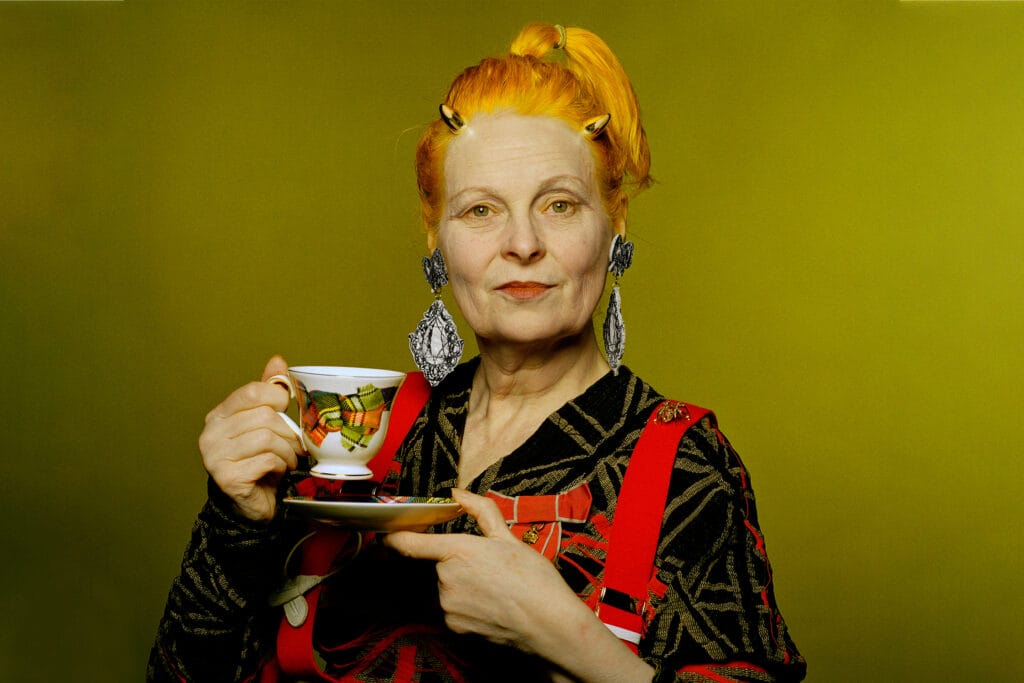Vivienne Westwood, an indomitable force in the annals of fashion, stands as an enduring icon whose work transcends the ephemeral whims of trend. Her oeuvre is characterized by an audacious amalgamation of punk insouciance and high-fashion sophistication. Through an oeuvre that spans over five decades, Westwood has redefined sartorial conventions and instigated a paradigm shift within the haute couture sphere. Her creations are not mere garments but profound statements—a synthesis of rebellion, art, and political commentary. This extensive exploration of Vivienne Westwood’s career, aesthetic philosophy, and legacy delves into the intricacies of her impact on fashion, society, and culture.

Early Life and Formative Influences
Childhood and Adolescence
Born Vivienne Isabel Swire on April 8, 1941, in the industrial town of Glossop, Derbyshire, Westwood’s humble beginnings belied the revolutionary path she was destined to forge. Her early years were marked by a fervent curiosity and a precocious talent for craft, skills she would later harness to subvert the fashion establishment. Raised in a working-class family, Westwood’s early life was characterized by economic austerity, which ingrained in her a profound appreciation for resourcefulness and creativity.
Her parents, Gordon Swire and Dora Ball, provided a stable yet unremarkable domestic environment. Gordon was a storekeeper in an aircraft factory, while Dora worked at a local cotton mill. Despite the lack of opulence, young Vivienne found solace and inspiration in her surroundings. The pastoral beauty of the Peak District, juxtaposed with the industrial backdrop of Glossop, imbued her with a unique aesthetic sensibility that would later manifest in her designs.
Education and Early Career
A brief stint at Harrow School of Art laid the groundwork for her artistic endeavors, though it was her self-driven education and innate ingenuity that truly honed her craft. Her formal education at Harrow was cut short when she decided to leave after just one term, disillusioned by the institution’s rigid structure and conventional approach. Westwood’s departure from Harrow marked the beginning of her autodidactic journey, wherein she immersed herself in various artistic and intellectual pursuits.
Her early career was marked by a series of eclectic ventures, ranging from jewelry making to primary school teaching. During this period, Westwood developed a profound appreciation for historical fashion, art, and literature. Her voracious appetite for knowledge and insatiable curiosity would later inform her designs, imbuing them with a depth and complexity that set her apart from her contemporaries.
Partnership with Malcolm McLaren
Her marriage to Derek Westwood in 1962 marked the beginning of her eponymous legacy, though it was her partnership with Malcolm McLaren, manager of the Sex Pistols, that catalyzed her ascent within the fashion world. Their collaboration engendered a radical new aesthetic that merged the raw energy of punk rock with a trenchant critique of societal norms. McLaren, a charismatic and visionary impresario, recognized Westwood’s potential and provided the platform for her to showcase her talents.
The couple’s first joint venture, a boutique named Let It Rock, opened in 1971 at 430 King’s Road, London. The boutique, which initially focused on 1950s Teddy Boy style, underwent several transformations, each reflecting the evolving cultural landscape and the duo’s burgeoning influence. It was this synergy between Westwood and McLaren that birthed the punk aesthetic, a revolutionary movement that would redefine the fashion world.


The Birth of Punk: SEX and Seditionaries
The Genesis of Punk Fashion
The 1970s witnessed the genesis of punk, a subculture that repudiated the ostentatious opulence of the preceding decade. Westwood and McLaren’s boutique, originally named Let It Rock, underwent several incarnations before becoming the seminal SEX in 1974. The boutique, with its provocative name and controversial displays, became a crucible for punk culture. It was a place where fashion, music, and rebellion converged, giving rise to a new aesthetic that challenged societal conventions.
Westwood’s designs from this era, encapsulated in the Seditionaries collection, were characterized by their bricolage aesthetic. They amalgamated elements of fetish wear, bondage, and deconstructed tailoring, creating garments that were both subversive and confrontational. The use of safety pins, shredded fabrics, and anarchic slogans transformed clothing into a medium of political dissent, encapsulating the punk ethos of anti-establishmentarianism.
Iconic Pieces and Symbolism
The Seditionaries collection, introduced in 1976, epitomized the punk aesthetic with its raw and rebellious spirit. Iconic pieces such as the muslin shirts emblazoned with provocative graphics, the bondage trousers with their restrictive straps, and the anarchic T-shirts featuring controversial imagery and slogans became symbols of a countercultural revolution. These garments were not merely fashion statements; they were acts of defiance against the status quo.
The symbolism inherent in Westwood’s designs extended beyond mere aesthetics. The use of tartan, traditionally associated with Scottish heritage, was recontextualized to signify rebellion and subversion. Similarly, the appropriation of militaristic elements, such as epaulettes and insignias, served to critique authority and institutional power. Westwood’s genius lay in her ability to imbue her creations with layered meanings, transforming fashion into a potent form of socio-political commentary.
Punk’s Impact on Society and Culture
The impact of punk fashion on society and culture was profound and far-reaching. It challenged conventional notions of beauty and elegance, celebrating individuality and self-expression over conformity. Punk fashion democratized style, making it accessible to the masses and encouraging a do-it-yourself ethos. This democratization of fashion was revolutionary, breaking down the barriers between high and low culture and fostering a new sense of creativity and innovation.
The influence of punk extended beyond the realm of fashion, permeating music, art, and literature. The Sex Pistols, managed by McLaren and styled by Westwood, became the quintessential punk band, their music and image epitomizing the movement’s rebellious spirit. The visual language of punk, with its DIY aesthetics and subversive graphics, inspired a new wave of artists and designers, cementing its place in the cultural zeitgeist.

Ascension to the High Fashion Pantheon
The Pirates Collection: A New Direction
The transition from subcultural iconoclast to high fashion luminary was neither immediate nor seamless. Westwood’s 1981 collection, Pirates, marked her first foray onto the international fashion stage. The collection, inspired by historical costume and buccaneer lore, was a radical departure from her punk roots. It featured voluminous silhouettes, ornate fabrics, and anachronistic detailing, juxtaposing romanticism with rebellion.
Pirates was a bold statement, signaling Westwood’s intent to transcend the confines of subcultural fashion and engage with a broader historical and cultural narrative. The collection was a resounding success, earning critical acclaim and establishing Westwood as a formidable talent within the high fashion world. The intricate craftsmanship and innovative silhouettes demonstrated her technical prowess and creative vision, garnering praise from fashion critics and industry insiders alike.
Historical References and Anachronism
This period also saw the establishment of Westwood’s eponymous label, a venture that would solidify her status within the haute couture echelon. Her subsequent collections—Savage (1982), Buffalo Girls (1982-1983), and Witches (1983)—continued to explore historical and cultural motifs, each imbued with her signature subversive edge. Westwood’s fascination with history and anachronism became a defining feature of her work, allowing her to draw on a rich tapestry of influences and reinterpret them through a contemporary lens.
Her historical references were not mere pastiche but rather a means of engaging with and critiquing the present. By reimagining historical garments, Westwood challenged the linear progression of fashion history and questioned the notion of cultural continuity. Her work invited viewers to reconsider the past and its relevance to contemporary issues, creating a dialogue between different temporalities.

Technical Innovation and Craftsmanship
Westwood’s ability to oscillate between the avant-garde and the historical, while maintaining an undercurrent of punk irreverence, garnered critical acclaim and commercial success. Her work was lauded for its intellectual rigor and artisanal craftsmanship, qualities that set her apart from her contemporaries. Westwood’s technical innovation and attention to detail were evident in her meticulous tailoring, complex drapery, and intricate embellishments.
Her exploration of traditional tailoring techniques, such as the corset and the crinoline, demonstrated her mastery of garment construction and her ability to reinterpret historical forms in innovative ways. Westwood’s corsets, for instance, became iconic pieces, celebrated for their ability to sculpt the body while challenging conventional notions of femininity and beauty. Her mastery of drapery and fabric manipulation allowed her to create garments that were both sculptural and fluid, pushing the boundaries of fashion design.
Critical Reception and Awards
Westwood’s contributions to fashion were recognized with numerous accolades and awards. In 1990, she was named British Designer of the Year, a title she would win again in 1991. Her influence extended beyond the fashion industry, earning her recognition from cultural and academic institutions. In 1992, she was awarded an OBE (Order of the British Empire) for her services to fashion, a distinction that underscored her status as a cultural icon.
Her critical reception was characterized by a deep appreciation for her originality, intellectual depth, and technical skill. Fashion critics lauded her ability to fuse historical references with contemporary aesthetics, creating collections that were both visually stunning and conceptually rich. Westwood’s work was celebrated for its ability to challenge conventions and provoke thought, elevating fashion to the realm of art and intellectual inquiry.



The Politicization of Fashion
Environmental Activism and the Climate Revolution
Westwood’s oeuvre is not merely an aesthetic endeavor but a vehicle for political expression. Her designs frequently engage with socio-political issues, from climate change to civil liberties. The “Climate Revolution” initiative, launched in 2012, epitomizes her commitment to environmental activism. Through this campaign, Westwood sought to raise awareness about the catastrophic impact of climate change, advocating for sustainable practices within the fashion industry and beyond.
Her environmental activism was informed by a profound sense of urgency and a belief in the power of fashion to effect change. Westwood’s campaigns emphasized the importance of reducing consumption, promoting sustainable materials, and supporting ethical labor practices. She used her platform to amplify the voices of environmental activists and raise awareness about the interconnectedness of fashion, politics, and the environment.
Political Commentary and Social Critique
Her collections often serve as a commentary on contemporary issues. The Propaganda collection (2005), for instance, was a scathing critique of media manipulation and political deceit. Garments emblazoned with slogans such as “I AM NOT A TERRORIST” and “PROPAGANDA” interrogated the mechanisms of power and control, urging the wearer to question dominant narratives. Westwood’s designs became a medium for social critique, challenging viewers to engage with pressing political and cultural issues.
Westwood’s political commentary extended beyond her collections, influencing her public persona and activism. She was an outspoken critic of governmental policies, corporate greed, and social injustice. Her activism was characterized by a commitment to social justice and a belief in the power of collective action. Westwood’s work demonstrated that fashion could be a potent form of political expression, capable of challenging the status quo and advocating for change.
Collaboration with Human Rights Organizations
Westwood’s commitment to social and environmental justice led to collaborations with various human rights organizations. She partnered with Amnesty International, Greenpeace, and the Environmental Justice Foundation, using her platform to raise awareness about human rights abuses and environmental degradation. These collaborations underscored Westwood’s belief in the interconnectedness of fashion, politics, and activism.
Her work with these organizations involved not only fundraising and awareness campaigns but also the creation of limited-edition garments and accessories that highlighted specific issues. For example, her collaboration with Greenpeace in 2014 resulted in the Save the Arctic campaign, which aimed to protect the Arctic region from oil drilling and climate change. The campaign featured a series of T-shirts and accessories emblazoned with striking imagery and slogans, drawing attention to the urgent need for environmental protection.

The Alchemy of Punk and Haute Couture
Fusion of High and Low Culture
Westwood’s work is characterized by a profound synthesis of punk and haute couture—a dialectical interplay that subverts and redefines the parameters of fashion. Her designs are imbued with a sense of anarchy and irreverence, yet they are executed with meticulous precision and artisanal craftsmanship. This alchemical fusion of high and low culture is a defining feature of Westwood’s oeuvre, allowing her to challenge and redefine the boundaries of fashion.
The interplay between high and low culture is a recurrent theme in Westwood’s work. Her collections frequently juxtapose luxurious fabrics with distressed detailing, creating a tension between refinement and rawness. This alchemical fusion is perhaps most evident in her reinterpretations of traditional British tailoring. By deconstructing and reconfiguring the classic suit, Westwood challenges the sartorial conventions of masculinity and power, imbuing the garment with a subversive edge.
Deconstruction and Reconfiguration
Westwood’s deconstruction and reconfiguration of traditional garments exemplify her innovative approach to fashion design. Her ability to dismantle and reassemble garments, creating new forms and silhouettes, is a testament to her technical skill and creative vision. This process of deconstruction and reconfiguration allows Westwood to challenge conventional notions of fashion and create garments that are both avant-garde and wearable.
One of the most iconic examples of Westwood’s deconstructive approach is her reinterpretation of the classic trench coat. By deconstructing the traditional garment and reassembling it with unexpected elements such as asymmetrical hems, oversized buttons, and exaggerated lapels, Westwood transforms the trench coat into a statement piece that challenges conventional notions of elegance and functionality.
The Corset: Reinvention and Empowerment
The corset, a recurring motif in Westwood’s work, exemplifies her ability to reinterpret historical garments in innovative ways. Traditionally associated with restrictive notions of femininity and beauty, the corset becomes a symbol of empowerment and rebellion in Westwood’s hands. Her corsets are designed to celebrate the body’s natural form, emphasizing curves and contours while challenging conventional standards of beauty.
Westwood’s corsets are celebrated for their intricate craftsmanship and innovative design. By incorporating elements such as boning, lacing, and structural support, she creates garments that sculpt and shape the body while allowing for movement and comfort. The corset, once a symbol of oppression, becomes a statement of empowerment and individuality in Westwood’s work.


The Vivienne Westwood Muse: Subversion and Individuality
The Vivienne Westwood muse is a figure of subversion and individuality, embodying the designer’s rebellious spirit and innovative vision. Westwood’s designs celebrate individuality and self-expression, encouraging the wearer to challenge conventions and embrace their unique identity. Her work is characterized by a sense of playfulness and irreverence, inviting the wearer to engage with fashion in a dynamic and creative way.
Westwood’s muses, from the punk icons of the 1970s to the avant-garde fashionistas of today, embody the designer’s ethos of rebellion and innovation. Her work encourages the wearer to embrace their individuality and challenge societal norms, creating a sense of empowerment and self-confidence. The Vivienne Westwood muse is a testament to the transformative power of fashion, demonstrating that style can be a potent form of self-expression and cultural critique.
The Legacy of Vivienne Westwood
Influence on Contemporary Fashion
Vivienne Westwood’s impact on the fashion world is immeasurable. Her radical approach to design has inspired generations of designers, challenging them to rethink the boundaries of fashion. Her legacy is not confined to her garments but extends to her ethos of rebellion and innovation.
Westwood’s influence is evident in the work of contemporary designers such as Alexander McQueen, John Galliano, and Gareth Pugh, who have drawn on her punk sensibility and avant-garde approach. McQueen, in particular, was profoundly influenced by Westwood’s work, incorporating elements of subversion, historical reference, and technical innovation into his own designs. Galliano’s theatrical and opulent creations also bear the imprint of Westwood’s influence, while Pugh’s avant-garde and experimental approach echoes her rebellious spirit.

Fashion as a Medium for Political and Social Change
Westwood’s work has also redefined the role of fashion as a medium for political and social change. Her commitment to environmental activism, human rights, and social justice has demonstrated that fashion can be a powerful platform for advocacy and change. Westwood’s work has inspired a new generation of designers and activists to use fashion as a tool for social and environmental justice, challenging the industry to become more sustainable and ethical.
Her legacy extends beyond the realm of fashion, influencing cultural and political discourse. Westwood’s activism has highlighted the interconnectedness of fashion, politics, and society, encouraging a more holistic and conscious approach to design and consumption. Her work has demonstrated that fashion can be a potent form of political expression, capable of challenging the status quo and advocating for change.
The Enduring Appeal of Punk Aesthetics
The enduring appeal of punk aesthetics is a testament to Westwood’s influence and legacy. The punk movement, with its emphasis on individuality, rebellion, and DIY ethos, continues to inspire contemporary fashion and culture. Westwood’s work has ensured that the spirit of punk remains alive and relevant, resonating with new generations of designers, artists, and activists.
The DIY ethos of punk, which emphasizes creativity, resourcefulness, and self-expression, has become a defining feature of contemporary fashion. Designers and consumers alike are embracing a more sustainable and ethical approach to fashion, inspired by the punk movement’s emphasis on individuality and creativity. Westwood’s work has demonstrated that fashion can be a powerful tool for self-expression and cultural critique, encouraging a more conscious and innovative approach to design and consumption.
Vivienne Westwood’s Impact on Gender and Identity
Westwood’s work has also had a profound impact on the way fashion engages with issues of gender and identity. Her designs challenge conventional notions of masculinity and femininity, creating garments that celebrate individuality and self-expression. Westwood’s work has encouraged a more fluid and inclusive approach to fashion, breaking down traditional gender boundaries and embracing a more diverse and dynamic vision of beauty and identity.
Her exploration of androgyny and gender fluidity has influenced a new generation of designers and consumers, encouraging a more inclusive and progressive approach to fashion. Westwood’s work has demonstrated that fashion can be a powerful tool for challenging societal norms and advocating for greater acceptance and understanding of diverse identities.




The Future of Vivienne Westwood’s Legacy
Vivienne Westwood’s legacy is assured, her influence continuing to resonate within the fashion world and beyond. Her work has demonstrated the transformative power of fashion, challenging conventions and inspiring innovation. Westwood’s commitment to social and environmental justice, her celebration of individuality and self-expression, and her innovative approach to design have ensured her place as a cultural icon and a true visionary.
As the fashion industry continues to evolve, Westwood’s legacy will remain a guiding force, inspiring new generations of designers, activists, and consumers to embrace creativity, individuality, and sustainability. Her work has demonstrated that fashion can be a powerful tool for change, capable of challenging the status quo and advocating for a more just and equitable world.
Conclusion
Vivienne Westwood’s career is a testament to the transformative power of fashion. Through her unique punk style and innovative creations, she has redefined the boundaries of haute couture, challenging the status quo and inspiring generations of designers. Her work is a celebration of individuality and rebellion, a reminder that fashion can be both a form of self-expression and a catalyst for change.
In an industry often characterized by its ephemerality, Westwood’s enduring legacy serves as a reminder of the profound impact that one visionary designer can have on the world. Her designs are not merely garments but profound statements, a synthesis of rebellion, art, and political commentary. Vivienne Westwood is not just a fashion designer; she is a cultural icon, a revolutionary, and a true artist. Her work has demonstrated that fashion can be a powerful tool for challenging conventions, advocating for change, and celebrating individuality. Westwood’s legacy will continue to inspire and influence the fashion world for generations to come, ensuring that her revolutionary spirit and visionary approach remain at the forefront of contemporary fashion and culture.






